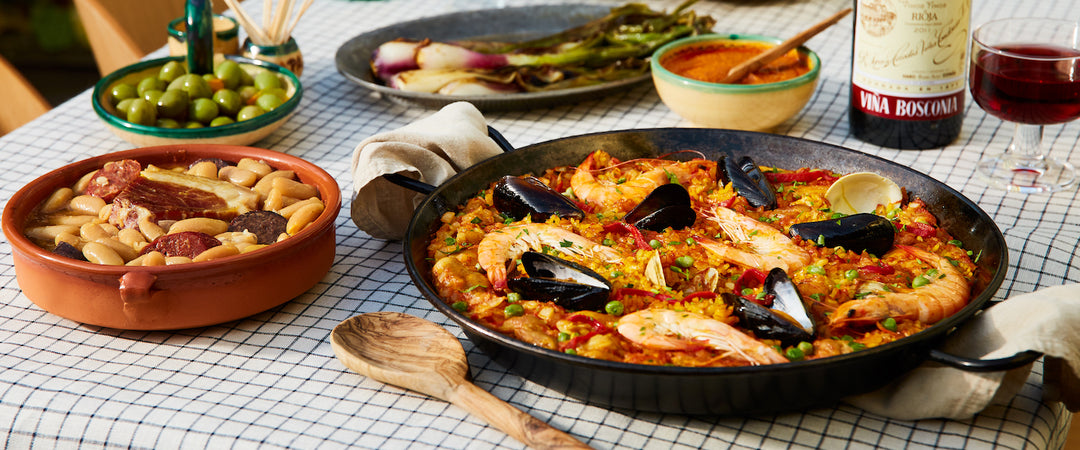April 2025 Tinto Club
  
|
La Vizcaina 2021 La Polousa
|
“Obession” would be an apt word to describe our attitude towards Raúl Pérez. One place to begin to talk about his influence is with the rise of ‘The New Spain’ in the world of winemaking. A bit of context here, over the course of the 20th century Spain’s top wine regions undergo widespread modernization, largely influenced by Bordeaux winemaking culture and enologogy. To this day, regions such as Rioja are based on this model of larger production, heavy-handed winemaking. Not to say this style of wine is bad, there is surely a time and a place for a bold, spicy red. However, in recent years there has been a rising interest among winemaker for small production, terroir-driven, low intervention winemaking and consumers have overwhelmingly taken notice. This culture shift, alongside a generation of young maverick winemakers, is what's largely known at ‘The New Spain’ in the wine world, and Raúl Pérez has been and remains an integral part of the movement.
On a personal note, as customer-facing wine industry members, we are too often confronted with the conversation of “what is natural wine?”, as the term lacks any specific or legally binding definition. While we’ll put off that rabbit hole for another blog post, one of our favorite ways to disrupt natural wine connotations amongst our customers is to show them the wines of Raúl Pérez. On paper, they check all the boxes that generally qualify natural wines: Organic sustainable farming, minimalist intervention, and low additional sulfites. But the drinking experience is far from the opaque and heavily funky expressions people often accociate with the genre. Sure, some contain a rustic edge, but the heart of his wines are classically Old World and above all else, cohesive and balanced. No wonder his meteoric rise in popularity within the natural wine world and beyond.
Speaking of the Old World, this month’s Wine club selection has a fascinating piece of historical background. The story goes, as European monks pilgrimaged across the Camino de Santiago through northern Spain, they brought with them grape vines as gifts for the monasteries at which they stayed. These grape vines were ultimately planted amongst the pre-existing vineyards in the area, creating a patchwork of colorful and varied grapes whose names have oft been forgotten. While these vines have needed to be replanted over the centuries, the tradition of maintaining the patchwork is common for the region. La Poulosa represents one of these vineyards and while some of the vines are quite old, Pérez has painstakingly nursed them to full health through organic viticulture. While the label may declare the wine is Mencía, it really contains a multitude of varietals, some of whom are not allowed or even acknowledged by the Bierzo D.O. legal classification.
La Poulosa is a low, east-facing vineyard with clay-rich soils and alluvial stones, with most of its vines dating back to the 1940s. True to Bierzo, the vineyard is Mencía dominant, shortly followed by Garnacha Tintorera (Alicante Bouschet) and Bastardo (Trousseau). True to the region, there are a multitude of other vines scattered amongst rows, many of whose names have been lost to time. As per usual in a field blend, these grapes are harvested without sorting by type, and the lot is whole-cluster fermented in seasoned open-top oak vats. The wine ages year in 225 and 500 liter used-oak barrels before bottling. As one may be able to glean, Rául Pérez is a deeply humble winemaker. While his family has been in wine for over 300 years and he has been named winemaker of the year by multiple publications, our distributor said it best, “These are not “winemaker” wines so much as they are unadulterated expressions of the villages and vineyards from which they hail.” and we could not agree more. Heavy winemaking techniques are not the focus here. Varietal character and purity of terroir are definitely at the forefront of Pérez’s focus. Dark berries, tart black cherry and wild strawberry notes are followed by ethereal baking spices, vanilla, and subtle pepperiness. Pair with rustic stews, earthy cheeses, or just sit and take it in. Above anything else, this wine is an expression of a place, and we are more than excited to feature it.
  
|
Zarate 2023 FronteconRegular Price: $46.99
Club Price: $39.94
|
While my co-writer for the other club wines noted that the theme for a lot of our wines was “old vines”, and I agree, I also noticed that we seemed to gravitate towards the unusual for our Tinto and Blanco Y Tinto clubs this month. We have been featuring a lot of beautiful Garnachas and Tempranillos from regions we are all familiar with. Thus, when Zarate’s Frontecon hit our palates during our hunt for club-worthty wine, a light bulb went off. Espadeiro? Red from Galicia? Chillable? Sign us up. What also helped is that we liked it so much, we threw professional wine tasting manners (i.e. always spit it out) aside, clocked out, and just kept drinking the sample bottle we had been provided. A wine we can’t stop drinking is a wine worthy of you, our customers. With that as an introduction, let’s dive into what makes this wine so special.
Bodegas Zárate, established in 1707, is a historic winery located in the Salnés Valley sub-region of Rías Baixas, Galicia, in northwestern Spain. For those new to Spain, this is the region that many call “green Spain”, a wide belt of land full of sandy beaches, rocky shores, fjordlike estuaries, forested hills and among it all spectacular vineyards. The region spans from along the Minho river on the border with Portugal in the south and west to the forested hills bordering Asturias to the east.


This part of Spain has a moderate marine climate with temperatures rarely dropping below freezing or rising above 75ºF. It has lots of rainfall (40") for most of the year. Below a climate chart for Vigo, close enough to Pontevedra to be representative. It’s a stark contrast to Spain’s arid southern regions.

Image courtesy and (c) https://www.climatestotravel.com/climate/spain/galicia
Zarate is in the Val do Salnes, a finger of land towards the more southern part of Galicia, with lots of exposure and very close to the Atlantic. It's one of Rias Baixas most prized microclimates. There, the Zarate estate spans approximately 10 hectares across 11 parcels, primarily planted with Albariño, along with indigenous red varieties like Loureiro Tinto and Caiño Tinto. Notably, in 1850, the estate planted El Palomar, Rías Baixas’ oldest documented pre-phylloxera Albariño vineyard, which continues to produce wine today. As can seen throughout Zarate’s own website, this is an estate deeply steeped in the history of Rias Biaxas and the Val do Salnes.



Images (c) Bodegas Zarate
Currently, the winery is managed by the seventh-generation winemaker, Eulogio Pomares, who took the helm in 1999. Pomares is recognized for his meticulous approach in both the vineyard and the cellar, drawing inspiration from renowned wine regions such as Burgundy, Barolo, and Champagne to refine his techniques. The vineyards are farmed organically, incorporating biodynamic practices, including the use of cover crops and homeopathic treatments like seaweed to balance soil nutrients. Eulogio is a genius with Albariño, making some of the finest Albariños from their various plots, with single vineyard bottlings like Balado, El Palomar and Tras da Vina. These are rarely seen in our shops not becasue we don't love them, but because they're rarely available due to being highly allocated. Yet, while Albariño is the estate’s main focus, in the words of importer Rare Wines:
“Eulogio’s brilliance isn’t limited solely to Albariño; he also makes fine reds from the native Espadeiro, Caiño Tinto and Loureiro Tinto varieties. Not only do they rank with Galicia’s finest, but they also honor the tintos that—prior to the phylloxera devastation of the 1890s—dominated viticulture in his locale, the Val do Salnés, in the heart of Rías Baixas.”
With this background, let’s turn our attention to what’s in the bottle. Espadeiro and Caiño Tinto, the two native grape varieties behind Zárate’s Frontecon, offer a rare and captivating glimpse into Galicia’s nearly forgotten red wine tradition. Espadeiro is a thin-skinned, late-ripening grape that thrives in the cool, damp Atlantic climate of Rías Baixas, yielding wines with striking acidity, vivid red berry flavors, and a delicate, almost floral character. Its light body and natural brightness make it especially refreshing, often suited to slight chilling, though its cultivation is challenging due to its susceptibility to rot and mildew. By contrast, Caiño Tinto brings a darker, more brooding dimension to the blend. It ripens late as well, but its thick skins and compact clusters provide greater resistance to disease, and in the glass, it delivers structure, minerality, and savory notes of black pepper, herbs, and occasionally cured meat. Where Espadeiro lifts the wine with its zippy red fruit and mouthwatering freshness, Caiño grounds it with tannin, spice, and earthy complexity. Together, they create a wine that is both lively and layered—light on its feet but deep in expression—highlighting the enormous potential of Galicia’s red grapes when treated with care and intention. These varieties are exceedingly rare today, as the region is overwhelmingly dominated by white Albariño production, making wines like Frontecon a compelling and authentic expression of local history and viticulture. The grapes for this wine are grown on "a plot located in Padrenda that is particularly suited to red varieties. Granitic soils with small percentage of red clay" according to imported Rare Wines.
As you drink this wine, pay careful attention to how multilayered the palate is. It starts with fresh sour cherries, then broadens into juicy berries, maybe a bit of forest strawberry, then finishes with earth, spicy warmth, all while managing to stay very light, not cloying or rich. It reminds me of the flocks of Starlings we see in Sonoma in the fall. One minute the intense cloud of birds is all over, the next it’s aloft and gone. Food pairings? Like the place where my analogous birds took off to, the sky’s the limit.
Because Frontecon is light, zippy, and slightly rustic, it shines with foods that echo its brightness and texture. Think Galician-style octopus with paprika and olive oil, where the wine’s acidity cuts through the richness while its peppery notes mirror the seasoning.
 image used by permission (c) iStock
image used by permission (c) iStock
Grilled oily fish like sardines or mackerel, common in coastal Spanish cuisine, are also a natural fit, especially when served with a squeeze of lemon or vinegary sauces. Frontecon also handles grilled chicken or pork, especially when prepared with Mediterranean herbs like rosemary or thyme, or served alongside roasted red peppers and olives. Its acidity makes it a sleeper hit with more everyday, tomato-based dishes, such as ratatouille, pasta with puttanesca sauce, or even margarita pizza, although the latter would have to be an amazing Margarita to no turn it into too banal of a pairing. For a more regionally authentic twist, try it with empanadas Gallegas—especially those filled with tuna, onions, and peppers. And, not to forget about those who don’t eat meat, Vegetarians will find joy pairing this wine with roasted beets, mushroom tapas, or lentil salads with vinaigrette, where earthy and tangy elements reflect and enhance the wine’s own savory depth. Served slightly chilled, this wine is a multi-talented team player. I for my part will prefer to have it with a good friend in contemplative, or maybe even argumentative conversations. Like I said, this wine’s a team player.



